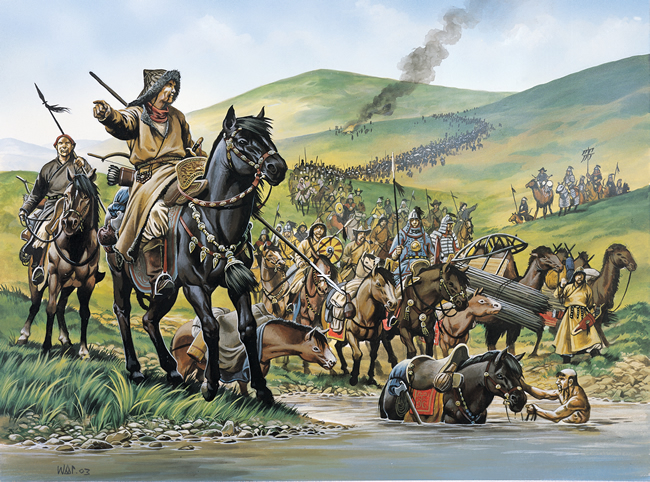 |
| Subotai |
Subotai was probably the greatest Mongolian general of the period of Mongolian empire and played an important role in its establishment and expansion. He was likely from Uriyangqai, the region lying between the Onon and Kerulen Rivers, and came into the service of the young Mongol chieftain Genghis Khan (r. 1206–27) primarily through a long-term family association.
Subotai was an important member of Genghis Khan’s guards by the early part of the 13th century and had already distinguished himself in the latter’s service.
In 1204 Genghis Khan defeated the league formed against him by Tayang-qan of the Naiman, with the active participation of Subotai. The future khan’s enemies were now defeated or dead or had migrated out of Mongolia to flee his wrath.
Among those fleeing were a group of Naiman survivors led by Gücülük, and another group of Merkit led by their chief Toqto’a-beki. Since such groups could recuperate quickly, ally with others, and constitute a major threat to Genghis Khan’s new regime, it was vital to pursue them.
Charged with the task, among others, were Jebe, another talented Mongolian general, and Subotai, initiating at first a general reconnaissance, then an advance west, extending over a decade and a half.
In 1208 Juji, the oldest son of Genghis Khan, defeated the Merkit group in a great battle on the Irtysh River. Toqto’a-beki was killed but his sons, led by Qudu, took their father’s head with them and fled south into Uighur domains.
 |
| Merkit group |
Sent in pursuit were Jebe and Subotai, securing the submission of the Bešbaliq Uighurs on the way, who participated in a battle against Qudu, who was weakened but escaped, on the banks of the Djem or Cem River (1209).
By that time the situation in eastern Turkistan, long ruled by the Qara-Khitan, was in flux, and the appearance of the Naiman Gücülük further unsettled things. He eventually seized power but even as a refugee constituted a major threat to the new Mongol regime.
Faced with a situation beyond their resources, Jebe and Subotai did what good Mongol commanders almost always did: They concentrated against the enemy more easily dealt with, Qudu, and kept the other under close supervision.
Subotai went after Qudu, and Jebe pursued Gücülük as far as he could into Qara-Khitan territory, without coming into conflict with the still powerful Qara-Khitan ruler. Satisfied that his enemy was no longer an immediate threat, Jebe then joined with Subotai to defeat the Merkit survivors once and for all.
By this time the Merkit were allied with a group of Qangli, a Turkic people, but they were all but destroyed in the battle (1209) at a site called Jade Valley, in the Chinese sources.
Unfortunately before they could return home, mission accomplished, the two Mongol generals encountered a new, unexpected enemy, the Khwarazm-shah Muhammad, and engaged in a clash with him, which was indecisive.
The Mongols withdrew after kindling fake campfires to mask their movements. In the wake of the advances of Jebe and Subotai, the Qangli and Qarluq, another Turkic people, submitted.
Recalled home, both Jebe and Subotai participated in the general assault on the Jin (Chin) dynasty (1125– 1234) in China, leading to the fall of the Jin central capital of Zhongdu (Chungtu) in 1215, the real beginning of Mongolian control in China.
Sent west again, the two Mongol generals protected Mongol interests there and participated in the selesai pursuit of Gücülük, leading to his death in 1218. Eastern Turkistan and large chunks of southern Siberia were under Mongol control, making the latter a serious threat to the Khwarazm-shah Muhammad.
War came soon after the famous Otrar Incident (1218), in which some merchants under the protection of the Mongol ruler were massacred at the orders of a local Khwarazmian official.
Faced with a general assault from, as was the Mongol custom, as many directions at once as possible, the Khwarazmian empire crumbled and the Khwarazm-shah, now a refugee, died on an island in the Caspian in 1220.
At the suggestion of Subotai, who with Jebe had actively participated in the campaign, the Mongols launched the greatest reconnaissance in force in history, an expedition through northern Iran, into the Caucasus, and then across the south Russian steppe, to link up again with other Mongol armies.
The expedition was a success, although Jebe died. On June 16, 1223, the two generals defeated a Russian allied force on the Kalkha River, the Mongols first encounter with a western power. Subotai participated as a senior commander in the selesai subjugation of Jin (by 1234).
 |
| Battle between Mongols and Russian allied force on the Kalkha river |
Although already an old man by 1235, about 59, Subotai was now tapped for his greatest role of all, that of strategic commander for a generalized Mongol advance to secure the palimony of Juji’s sons, who by tradition, were to receive the most distant pastures of his father in the extreme west of the Mongolian world.
As part of this advance, Subotai participated in the Mongol destruction of Kievan Russia (1237–40) and then was called upon to plan an even larger assault, on eastern Europe, during 1241.
Advancing along multiple lines, with coordinated columns, the Mongols overwhelmed all their opponents although the Hungarians proved somewhat tougher than expected, even though the latter were only partially mobilized.
Only the death of Ogotai Khan (r. 1229–41), the successor of Genghis Khan, seems to have prevented an even wider advance. Returning home, Subotai spent his last years either in the Mongolian homeland or on the borders of China. His sons and grandsons continued to serve Mongol rulers, including those of China.
EmoticonEmoticon